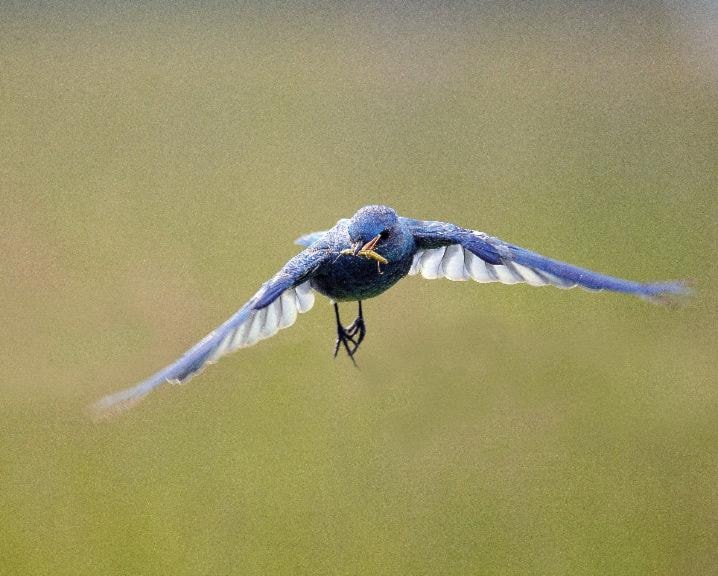SYLVAN LAKE — A red fox slips into the trees as she comes to the door, packing a Nikon digital camera with a honking big zoom lens attached.
“Shhhhh. I think he’s coming back.” She mouths rather than speaks the words as she peers into the twilight through her kitchen window.
Sure enough, in a few more minutes, a fox slips around to the north side of naturalist Myrna Pearman’s lakeside home, sniffing out the goodies she has thrown into the snow.
The fox’s bushy tail is almost as big as the rest of its body. It works as a portable duvet, wrapping around the animal when it curls up to sleep, says Pearman, manager of the Ellis Bird Farm and a strong advocate for preservation of native species, both flora and fauna.
Pearman’s photos appear monthly in the Red Deer Advocate.
Some of the best opportunities for photographing wildlife occur right outside the front door, says Pearman, whose course in life was set while she was still a teenager going to school in Rimbey.
Two local men were powerful influences in her decision to pursue a career that would blend her interest in photography with her desire to study and advocate for the natural world.
One of five children, Pearman got her first camera — a Kodak Instamatic — while she was at student at Rimbey Junior Senior High School.
School librarian Rolf Seidel had strong technical skills and operated his own wedding photography business.
Seidel become a close friend and mentor for Pearman, teaching her how to get the most from the twin-lens, medium-format cameras in vogue at the time, along with how to develop and print her own black and white pictures.
They maintained the friendship after Pearman’s graduation in 1973 and while she pursued a bachelor of science degree in physical geography at the University of Alberta.
Pearman chose the program because of the broad scope of studies that would be available to her, including geology, biology, ichthyology and ornithology.
“If you took physical geography, you were open to take all of the other classes,” she says.
“I took all of the ‘ologies’ I could take, anything related to natural history — anything related to the Earth. That gave me a really good grounding in the natural sciences.”
Pearman was still taking courses in 1978 when Seidel felt himself about to lose his long battle with cancer. He asked her take over his business, giving her all of his equipment and inventory, including client list, negatives, cameras and related equipment.
Members of Seidel’s family, who have always considered Pearman a close friend, felt that she was a natural choice to take over the business, says his daughter, Rebecca Seidel.
Pearman returned to Rimbey after completing her degree in 1979 and continued with the photography business alongside house cleaning and sweeping chimneys.
Her first roll of colour film was her life’s other game changer.
It was a time when people were very cautious about hitting the shutter button, because rolls of film were limited to anywhere from 10 to 36 images and developing and printing were expensive.
Fall colours were at their peak when Pearman ventured out to see what images she could capture.
After collecting her prints, she showed them to local naturalist and family friend Fred Schutz who, over the span of 40 years, published more than 2,200 West of the Blindman columns in the now defunct Rimbey Record.
“He just loved nature, so he shared that with us. When I took my first roll of colour pictures, he looked at them and he said, ‘Myrna, you’ve got talent.’ That was all I needed.”
Now 55, the bulk of Pearman’s working years have been spent at the Ellis Bird Farm, whose nest boxes, feeders and natural features provide a wealth of subjects.
Capturing those images is much easier with a high-end digital camera that is capable of shooting at nine frames per second and holds the electronic equivalent of 10 to 20 rolls of film, she says.
Capturing action like the straight-on image of a bluebird returning with a grasshopper for its babies or a fox in mid-jump as it hunts mice in the snow are much easier when there is a virtually unlimited supply of recording medium available, says Pearman.
To capture those images, she observes the subject’s behaviour, anticipates the moment and then holds the shutter open. The method has produced photos of animals in their most vulnerable and fascinating moments, such as a mother moose and her calves foraging in a stand of trees, a beaver packing a huge branch to rebuild the family home after a spring flood and a straight-on shot of a male bluebird, wings spread wide and packing a freshly-caught grasshopper to feed his family.
The delete button means the photographer can edit down to the images that work best, like her close-up of what may be one of the most hideous birds on the Prairies — the turkey vulture. The image is made even more disgusting with the small drop of green drool rolling off its lower beak.
The ease and versatility of digital cameras means even the most mediocre of photographers can sometimes capture brilliant images, says Pearman, who sees herself as an artist but not necessarily a great photographer.
Her intimate images of wild animals going about their daily business say otherwise.
bkossowan@www.reddeeradvocate.com
